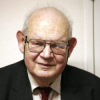Benoit Mandelbrot

Benoit Mandelbrot
Benoit B. Mandelbrot was a Polish-born, French and American mathematician with broad interests in the practical sciences, especially regarding what he labeled as "the art of roughness" of physical phenomena and "the uncontrolled element in life." He referred to himself as a "fractalist". He is recognized for his contribution to the field of fractal geometry, which included coining the word "fractal'", as well as developing a theory of "roughness and self-similarity" in nature...
NationalityFrench
ProfessionMathematician
Date of Birth20 November 1924
CountryFrance
I claim that many patterns of Nature are so irregular and fragmented, that, compared with Euclid-a term used in this work to denote all of standard geometry-Nature exhibits not simply a higher degree but an altogether different level of complexity ... The existence of these patterns challenges us to study these forms that Euclid leaves aside as being "formless," to investigate the morphology of the "amorphous."
I spent my time very nicely in many ways, but not fully satisfactory. Then I became Professor in France, but realized that I was not - for the job that I should spend my life in.
Nobody will deny that there is at least some roughness everywhere
Most were beginning to feel they had learned enough to last for the rest of their lives. They remained mathematicians, but largely went their own way.
Until a few years ago, the topics in my Ph.D. were unfashionable, but they are very popular today.
The techniques I developed for studying turbulence, like weather, also apply to the stock market
When the weather changes, nobody believes the laws of physics have changed. Similarly, I don't believe that when the stock market goes into terrible gyrations its rules have changed
I didn't want to become a pure mathematician, as a matter of fact, my uncle was one, so I knew what the pure mathematician was and I did not want to be a pure - I wanted to do something different.
The Mandelbrot set is the most complex mathematical object known to mankind.
If you have a hammer, use it everywhere you can, but I do not claim that everything is fractal.
I conceived, developed and applied in many areas a new geometry of nature, which finds order in chaotic shapes and processes. It grew without a name until 1975, when I coined a new word to denote it, fractal geometry, from the Latin word for irregular and broken up, fractus. Today you might say that, until fractal geometry became organized, my life had followed a fractal orbit.
In fact, I barely missed being number one in France in both schools. In particular I did very well in mathematical problems.
I don't seek power and do not run around
Asking the right questions is as important as answering them